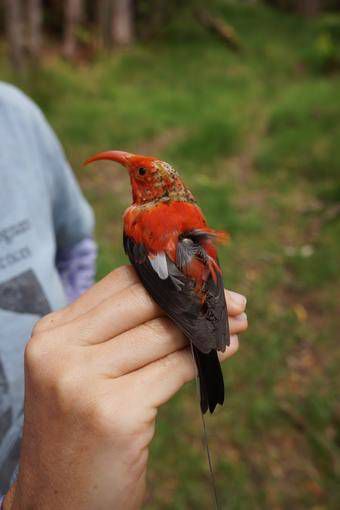ALAKAI SWAMP — A little blip of red flits through the ohia trees, chasing nectar all over Kauai’s Alakai plateau. It’s an ‘i‘iwi, Hawaii’s iconic honeycreeper, and it’s slowly disappearing from the forests of the archipelago, mainly due to a
ALAKAI SWAMP — A little blip of red flits through the ohia trees, chasing nectar all over Kauai’s Alakai plateau.
It’s an ‘i‘iwi, Hawaii’s iconic honeycreeper, and it’s slowly disappearing from the forests of the archipelago, mainly due to a low resistance to avian malaria, which is transmitted by mosquitoes.
But a new study tracking migration patterns of the birds could help save them.
“The main thing that we’ve been wondering for a long time is to what extent the birds contract malaria on the plateau and to what extent they contract malaria because they leave the plateau,” said Dr. Lisa “Cali” Crampton of the Kauai Forest Birds Recovery Project.
Knowing where the birds contract avian malaria will help target control efforts, largely in the realm of mosquito eradication.
“Understanding the movements of the birds and the movements of the mosquitoes are both key,” Crampton said.
The study, which was done by the U.S. Geological Survey on the Big Island, looked at the altitudinal seasonal migration of the birds. Using radio telemetry data, authors demonstrated that adult juvenile ‘i‘iwi follow blooming cycles of nectar-bearing flowers and venture into lowlands on Hawaii Island.
And while the ‘i‘iwi on Hawaii Island have an elevation range from sea level to around 14,000 feet, Kauai’s honeycreeper habitat is considerably smaller.
“Almost all of our native forests are restricted to high elevations to begin with, with a few exceptions,” Crampton said. “But that doesn’t mean that the birds don’t migrate out to non-native forests that have suitable nectars.”
Reports have been received of the birds venturing into non-native forests for blooming flowers. However, the Kauai Forest Birds Recovery Project has yet to confirm a sighting.
“But it would definitely put them in harm’s way even if they were just prospecting,” Crampton said. “The nature of the plateau is such that, especially in the north and east, it doesn’t take much to lose elevation because of the Napali.”
Mosquitoes are also occasionally found on the Alakai plateau, and Crampton said it would be beneficial to know where they’re coming from and their movement patterns, too.
“Within the plateau, the birds migrate toward whatever is blooming. We know that they’re chasing nectar, but we haven’t had the data or resources to look beyond the plateau,” Crampton said. “That’s our study area and core focus.”
Indications are that the ‘i‘iwi will be listed as threatened under the Endangered Species Act, and once that happens, the bird will be in the spotlight for the Kauai Forest Bird Recovery Project.
“In anticipation of its listing, we’ve just this year started collecting data on the ‘i‘iwi,” Crampton said.
Hawaiian honeycreepers are the “canary in the coal mine,” according to Samuel ‘Ohukani‘ohi‘a Gon, III, senior scientist and cultural adviser for The Nature Conservancy of Hawaii.
“The ‘i‘iwi provides a clear warning of the threats moving into Hawaii’s last sanctuaries for not only rare bird species, but our entire island ecosystem,” Gon said.
“Conservation efforts to save ‘i‘iwi are urgently needed to ensure that the future generations will continue to see the living legacy of our unique island home,” he said.
In addition to targeting mosquitoes, other conservation efforts include habitat restoration, which Crampton said is equally important.
“Birds that have more-intact native forests and that have the resources they need are less likely to wander,” she said. “We also suspect they may be more robust to sustain any malarial infection they might encounter.”


